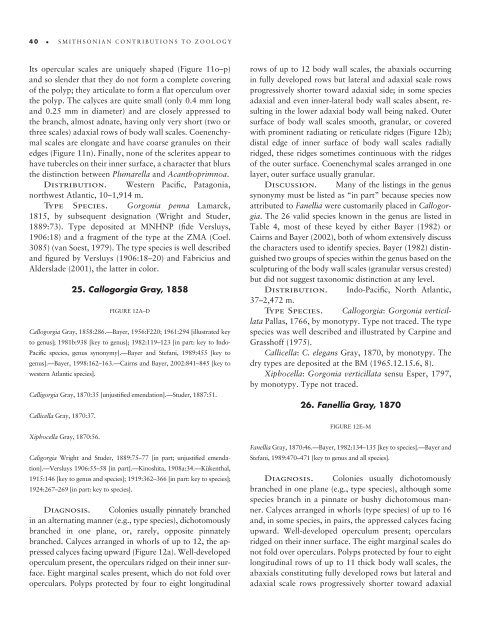A Generic Revision and Phylogenetic Analysis of the Primnoidae
A Generic Revision and Phylogenetic Analysis of the Primnoidae
A Generic Revision and Phylogenetic Analysis of the Primnoidae
You also want an ePaper? Increase the reach of your titles
YUMPU automatically turns print PDFs into web optimized ePapers that Google loves.
40 SMITHSONIAN CONTRIBUTIONS TO ZOOLOGY<br />
Its opercular scales are uniquely shaped (Figure 11o–p)<br />
<strong>and</strong> so slender that <strong>the</strong>y do not form a complete covering<br />
<strong>of</strong> <strong>the</strong> polyp; <strong>the</strong>y articulate to form a fl at operculum over<br />
<strong>the</strong> polyp. The calyces are quite small (only 0.4 mm long<br />
<strong>and</strong> 0.25 mm in diameter) <strong>and</strong> are closely appressed to<br />
<strong>the</strong> branch, almost adnate, having only very short (two or<br />
three scales) adaxial rows <strong>of</strong> body wall scales. Coenenchymal<br />
scales are elongate <strong>and</strong> have coarse granules on <strong>the</strong>ir<br />
edges (Figure 11n). Finally, none <strong>of</strong> <strong>the</strong> sclerites appear to<br />
have tubercles on <strong>the</strong>ir inner surface, a character that blurs<br />
<strong>the</strong> distinction between Plumarella <strong>and</strong> Acanthoprimnoa.<br />
Distribution. Western Pacifi c, Patagonia,<br />
northwest Atlantic, 10–1,914 m.<br />
Type Species. Gorgonia penna Lamarck,<br />
1815, by subsequent designation (Wright <strong>and</strong> Studer,<br />
1889:73). Type deposited at MNHNP (fi de Versluys,<br />
1906:18) <strong>and</strong> a fragment <strong>of</strong> <strong>the</strong> type at <strong>the</strong> ZMA (Coel.<br />
3085) (van Soest, 1979). The type species is well described<br />
<strong>and</strong> fi gured by Versluys (1906:18–20) <strong>and</strong> Fabricius <strong>and</strong><br />
Alderslade (2001), <strong>the</strong> latter in color.<br />
25. Callogorgia Gray, 1858<br />
FIGURE 12A–D<br />
Callogorgia Gray, 1858:286.—Bayer, 1956:F220; 1961:294 [illustrated key<br />
to genus]; 1981b:938 [key to genus]; 1982:119–123 [in part: key to Indo-<br />
Pacifi c species, genus synonymy].—Bayer <strong>and</strong> Stefani, 1989:455 [key to<br />
genus].—Bayer, 1998:162–163.—Cairns <strong>and</strong> Bayer, 2002:841–845 [key to<br />
western Atlantic species].<br />
Calligorgia Gray, 1870:35 [unjustifi ed emendation].—Studer, 1887:51.<br />
Callicella Gray, 1870:37.<br />
Xiphocella Gray, 1870:56.<br />
Caligorgia Wright <strong>and</strong> Studer, 1889:75–77 [in part; unjustifi ed emendation].—Versluys<br />
1906:55–58 [in part].—Kinoshita, 1908a:34.—Kükenthal,<br />
1915:146 [key to genus <strong>and</strong> species]; 1919:362–366 [in part: key to species];<br />
1924:267–269 [in part: key to species].<br />
Diagnosis. Colonies usually pinnately branched<br />
in an alternating manner (e.g., type species), dichotomously<br />
branched in one plane, or, rarely, opposite pinnately<br />
branched. Calyces arranged in whorls <strong>of</strong> up to 12, <strong>the</strong> appressed<br />
calyces facing upward (Figure 12a). Well-developed<br />
operculum present, <strong>the</strong> operculars ridged on <strong>the</strong>ir inner surface.<br />
Eight marginal scales present, which do not fold over<br />
operculars. Polyps protected by four to eight longitudinal<br />
rows <strong>of</strong> up to 12 body wall scales, <strong>the</strong> abaxials occurring<br />
in fully developed rows but lateral <strong>and</strong> adaxial scale rows<br />
progressively shorter toward adaxial side; in some species<br />
adaxial <strong>and</strong> even inner-lateral body wall scales absent, resulting<br />
in <strong>the</strong> lower adaxial body wall being naked. Outer<br />
surface <strong>of</strong> body wall scales smooth, granular, or covered<br />
with prominent radiating or reticulate ridges (Figure 12b);<br />
distal edge <strong>of</strong> inner surface <strong>of</strong> body wall scales radially<br />
ridged, <strong>the</strong>se ridges sometimes continuous with <strong>the</strong> ridges<br />
<strong>of</strong> <strong>the</strong> outer surface. Coenenchymal scales arranged in one<br />
layer, outer surface usually granular.<br />
Discussion. Many <strong>of</strong> <strong>the</strong> listings in <strong>the</strong> genus<br />
synonymy must be listed as “in part” because species now<br />
attributed to Fanellia were customarily placed in Callogorgia.<br />
The 26 valid species known in <strong>the</strong> genus are listed in<br />
Table 4, most <strong>of</strong> <strong>the</strong>se keyed by ei<strong>the</strong>r Bayer (1982) or<br />
Cairns <strong>and</strong> Bayer (2002), both <strong>of</strong> whom extensively discuss<br />
<strong>the</strong> characters used to identify species. Bayer (1982) distinguished<br />
two groups <strong>of</strong> species within <strong>the</strong> genus based on <strong>the</strong><br />
sculpturing <strong>of</strong> <strong>the</strong> body wall scales (granular versus crested)<br />
but did not suggest taxonomic distinction at any level.<br />
Distribution. Indo-Pacifi c, North Atlantic,<br />
37–2,472 m.<br />
Type Species. Callogorgia: Gorgonia verticillata<br />
Pallas, 1766, by monotypy. Type not traced. The type<br />
species was well described <strong>and</strong> illustrated by Carpine <strong>and</strong><br />
Grassh<strong>of</strong>f (1975).<br />
Callicella: C. elegans Gray, 1870, by monotypy. The<br />
dry types are deposited at <strong>the</strong> BM (1965.12.15.6, 8).<br />
Xiphocella: Gorgonia verticillata sensu Esper, 1797,<br />
by monotypy. Type not traced.<br />
26. Fanellia Gray, 1870<br />
FIGURE 12E–M<br />
Fanellia Gray, 1870:46.—Bayer, 1982:134–135 [key to species].—Bayer <strong>and</strong><br />
Stefani, 1989:470–471 [key to genus <strong>and</strong> all species].<br />
Diagnosis. Colonies usually dichotomously<br />
branched in one plane (e.g., type species), although some<br />
species branch in a pinnate or bushy dichotomous manner.<br />
Calyces arranged in whorls (type species) <strong>of</strong> up to 16<br />
<strong>and</strong>, in some species, in pairs, <strong>the</strong> appressed calyces facing<br />
upward. Well-developed operculum present; operculars<br />
ridged on <strong>the</strong>ir inner surface. The eight marginal scales do<br />
not fold over operculars. Polyps protected by four to eight<br />
longitudinal rows <strong>of</strong> up to 11 thick body wall scales, <strong>the</strong><br />
abaxials constituting fully developed rows but lateral <strong>and</strong><br />
adaxial scale rows progressively shorter toward adaxial

















